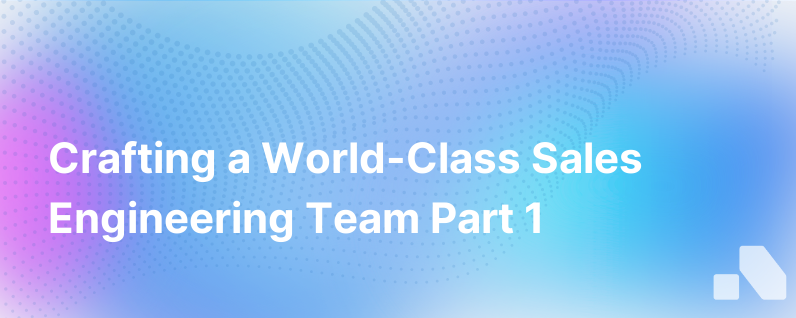
Sales Engineering (SE) is an indispensable function in any B2B technology company. It’s a unique blend that combines the deep technical knowledge of engineering with the finesse and results-driven mindset of sales. However, creating and nurturing a world-class SE organization is a complex task that requires a strategic approach to talent, processes, and tools.
In the first part of this two-part series, we delve into the foundational steps of building an SE team that not only delivers on its core mission — bridging the gap between technical solutions and business value — but also contributes significantly to the company’s sales success.
Understand the Role of Sales Engineering
Sales engineering, sometimes referred to as pre-sales engineering or systems engineering, is the functional bridge between the potential customer's requirements and the products or services that the company sells. SEs have a thorough understanding of the technical nuances of the product and the practical business applications. This dual expertise enables them to translate complex technical features into tangible benefits that meet the client's needs.
SE roles might include product demonstrations, technical presentations, proof of concept management, solution design and customization, RFP/RFI responses, and to some extent, customer advocacy post-sale. Developing a solid understanding of the unique value that SEs bring to the sales process is the first step in creating a formidable SE organization.
Hiring the Right Talent
Building a great SE team starts with recruiting the right people. While technical expertise is essential, the ideal candidate also possesses excellent communication skills, a problem-solving attitude, and the ability to build relationships with customers. Here are some aspects to consider when hiring:
- Technical Acumen: Look for deep technical knowledge relevant to your product or industry, and a genuine passion for technology.
- Sales Ability: While not necessarily from a sales background, the potential SE should show the ability to understand and articulate business value.
- Cultural Fit: The candidate should align with the company’s values and be a team player.
- Soft Skills: Pay close attention to candidates’ soft skills like communication, empathy, and adaptability — essential traits for customer-facing roles.
Structuring Your SE Organization
Creating the right structure for your SE organization can significantly affect its success. This structure will depend on your business model, sales process, and the complexity of your solutions, but commonly includes:
- Vertical Specialization: Align SEs with specific industries to leverage deep domain expertise.
- Territory Management: Structure the SE team regionally to be close to customers and prospects.
- Product Specialization: Have SEs focused on specific products.
- Dedicated vs. Shared Resources: Decide if SEs should be assigned to specific sales reps or serve as a shared resource pool.
Developing Sales Engineering Processes
Strong processes are crucial for scalability and predictability in sales engineering. These might include:
- Discovery: Standardized questions or checklists for the sales team to qualify prospects technically before engaging an SE.
- Demo Process: A defined process for customizing and conducting product demos.
- Proof of Concept (PoC) Protocol: A structured approach to managing and delivering PoCs with predefined success criteria.
- RFP/RFI Responses: Templates and content libraries for efficient and consistent RFP/RFI responses.
Tailoring a Training and Onboarding Program
Investing in continuous training and development ensures that SEs keep up with product changes and industry trends. Key elements of an SE training program should cover:
- Technical Training: Detailed knowledge about your product, integrations, and any relevant technology stack.
- Sales Methodology Training: Understanding of the company's sales approach and how SEs fit into the sales cycle.
- Soft Skills Development: Courses on consultative selling, negotiation, presentation skills, and relationship building.
- Mentoring and Shadowing: New SEs should shadow experienced team members to learn best practices.
Equipping with the Right Tools
SEs require a robust set of tools to maximize their efficiency and effectiveness. This toolkit might include:
- Demo Environments: Stable and scalable demo systems that can showcase your solution’s capabilities.
- Documentation and Knowledge Bases: Accessible and up-to-date technical documentation, solution architectures, FAQs, and best practices.
- Collaboration Tools: Tools that enable seamless collaboration between sales, SEs, product teams, and clients.
- Analytics and Monitoring: Systems to track and measure the impact of SE activity on sales outcomes.
Establishing Performance Metrics
To drive performance and continuous improvement, establish clear metrics that reflect both the quality and impact of SE work. Some key performance indicators (KPIs) can include:
- Win Rate: The percentage of deals won where an SE was involved.
- Sales Cycle: Influence of SEs on lengthening or shortening the sales cycle.
- PoC Success Rate: How often PoCs result in a sale.
- Customer Satisfaction: Feedback from customers on their interactions with SEs.
Fostering a Culture of Excellence
A high-performing SE team thrives in a culture that prioritizes excellence, accountability, collaboration, and customer success. Encourage knowledge sharing, celebrate wins, and learn from losses.
Creating a world-class SE organization is a formidable task, but it is also incredibly rewarding. It represents a strategic investment in the alignment and effectiveness of the technical and sales functions.
Stay tuned for Part 2, where we will explore the advanced strategies for scaling and optimizing your SE team to drive enterprise growth.
As you consider these foundational principles, remember that real-time insights and analytics can significantly enhance your SEs’ performance and efficiency. Platforms like Aomni cater to these needs by providing actionable insights promptly, allowing your SEs to focus more on delivering value and less on the heavy-lifting of data gathering. Stay tuned for the next part to build on the solid ground laid here.